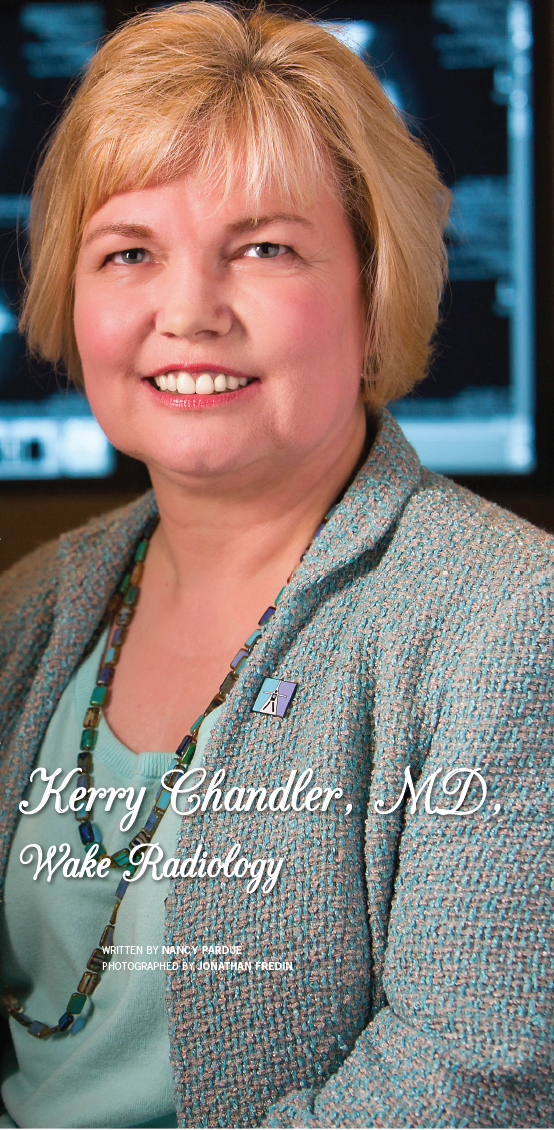When you’ve worked your way through medical school with a toddler in tow, there’s nothing you can’t do.
Dr. Kerry Chandler, director of breast imaging services at Wake Radiology, uses the memory of those challenging days as inspiration to work tirelessly on behalf of her patients.
“Balancing the demands of rearing a child and the heavy demands of medical training was extremely stressful,” Chandler said. “Luckily I had a very supportive family who helped me; my aunt even lived with me during the first part of my residency and helped with my son.”
Chandler’s passion for helping others has made any sacrifices worthwhile.
“I was always drawn to do something that would directly improve the health and well-being of people in a way that I could easily see. I also was drawn to a career in science, particularly biology. Medicine provided that mix,” she said.
“I can go home many evenings and know that since I found a small cancer in a woman’s breast, often years before she will feel it herself, I may very well have begun a chain of events that literally saves her life. I don’t wonder whether what I do is significant or not — I know it is.”
A New Jersey native, Chandler also trained in Albany, N.Y., and worked in Virginia before joining Wake Radiology in 1997.
“I have not looked back,” she said. “I love the Triangle region; we have most of the advantages of a very large metropolitan area without the crowding, and with the friendly feeling of a small town.”
Here, blending science and passion, her goal is simple: to tell fewer patients they have breast cancer.
“Yearly mammograms save women’s lives — that’s a fact,” Chandler said, speaking from Wake Radiology’s Comprehensive Breast Services & Bone Densitometry facility in Cary. Opened in 2007, it was among the first dedicated breast centers in the area, and is accredited by the American College of Radiology as a Breast Imaging Center of Excellence.
Chandler and a team of physicians, technologists and staff are credited with advances in mammography protocols here.
“We became more aggressive,” she said. “The transition to digital mammography in 2007 was a huge step forward, and one more catalyst to reorganizing how we’re doing things. It’s a specialized, controlled environment to maximize the number of cancers we find and minimize the number of unnecessary biopsies.”
Only 60 to 65 percent of women who should get annual mammograms actually do, Chandler says.
“Get your mammogram every year, from age 40 to 80,” she urges. “It’s something you do for yourself. Then go out to lunch, or take advantage of Saturday and evening appointments.”
No time? A screening mammogram can be done in 15 minutes, Chandler says.
Fear of radiation? “Compared to our yearly exposure from environmental radiation, the radiation in mammography is not very significant,” she said. “Don’t let unfounded fears keep you from having a mammogram.”
Chandler’s commitment to patient education is clear in her opposition to a 2009 report by the U.S. Preventative Services Task Force, which recommends doubling the interval between screening mammograms, discontinuing screening for women in their 40s, and discontinuing monthly self-exams for all women.
“My job as a doctor is to try to analyze the studies and simplify information for my patients,” Chandler said. “The American Cancer Society and Susan G. Komen (for the Cure) say to have mammograms yearly after 40, along with the American College of Obstetricians and Gynecologists, American College of Surgeons, and the American College of Radiology.”
Citing a 30-percent decrease in U.S. breast cancer deaths since regular mammography screening began, and analysis of her own patient data showing that small, previously undetected cancers were found via mammography in 56 women ages 40 to 49 over a period of 1.5 years, Chandler is adamant on the need for screening.
“The bottom line is that we don’t want to do more than necessary to treat and find cancers, but we will have a significant increase in mortality if we follow the USPSTF guidelines, and I have to speak out.
“The mortality rate in breast cancer is way down, but 40,000 people are still dying each year. And in African-American women, there’s less incidence of breast cancer but it’s more deadly when it does occur, and we don’t yet know why.”
In the community, Chandler, a former vice chief of staff for Johnston Health, has served as a speaker and participant in the American Cancer Society’s Relay for Life.
At home, she enjoys her family, including husband Gray, a “recently retired” minister, and son Daniel, now an adult. She also likes the beach, reading and painting, takes piano and French lessons, and mothers a puppy and a “geriatric” cat.
At work, she continues to measure success one patient at a time.
“Talent and intelligence are one thing, but perseverance and hard work are by far the most critical contributions to success,” Chandler said. “It’s so satisfying to be part of all this. If I do my job right and encourage people to get screened, we may save people from dying prematurely from breast cancer. How could it get any better than that?”





